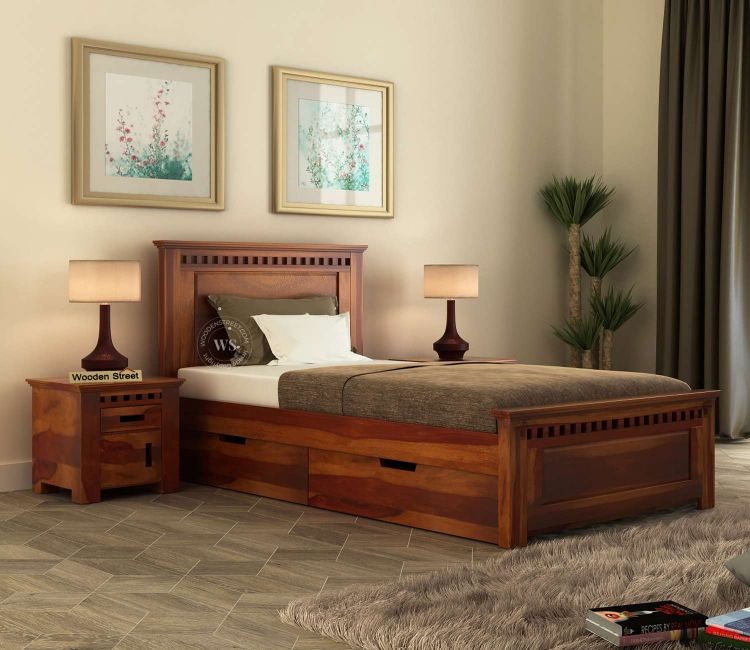What Is a Single Bed? Dimensions, Uses & Who It’s Best For

When it comes to choosing the right bed for your home, understanding the different sizes and their purposes is essential. One of the most versatile and space-efficient options is the single bed. Whether you’re furnishing a compact bedroom, setting up a kid’s room, or creating a cozy guest space, the single bed can be the perfect fit. In this guide, we’ll break down everything you need to know about the single bed — from dimensions to practical uses and who should consider one.
What Is a Single Bed?
A single bed is a compact-sized bed designed to accommodate one person comfortably. It’s the smallest standard bed size available, making it an ideal choice for smaller spaces or rooms that don’t require larger sleeping arrangements.
Despite its smaller size, a single bed doesn’t compromise on comfort. With the right mattress and frame, it offers a cozy and restful sleeping experience, especially when space is limited.
Standard Dimensions of a Single Bed
In India, the standard single bed dimensions are approximately:
- Width: 36 to 39 inches (91 to 99 cm)
- Length: 72 to 75 inches (183 to 190 cm)
These measurements may vary slightly based on the design or manufacturer, but they generally follow these dimensions. Some brands also offer extended-length single beds for taller individuals.
If you’re short on space, single beds are ideal because they provide sleeping functionality without overwhelming the room.
Key Uses of a Single Bed
The single bed is incredibly versatile and can be used in several settings:
1. Children’s Bedrooms
A single bed is perfect for kids and young teens. It provides enough sleeping space while leaving room for play, storage, and study setups. Many single bed frames come with safety rails or themed designs tailored for children.
2. Guest Rooms
If you frequently host visitors but don’t have extra space, a single bed allows you to set up a welcoming guest room without occupying too much floor area. It’s especially useful in multi-purpose rooms.
3. Hostels & Dormitories
In shared accommodation spaces like hostels and dorms, single beds are the standard choice. They offer personal space for sleeping while allowing multiple beds to fit in one room efficiently.
4. Studio Apartments
For individuals living alone in compact apartments or rented rooms, a single bed is the go-to solution for maximizing floor space.
5. Daybeds or Lounging Areas
Some single beds double as daybeds or lounges during the day, especially when accessorized with cushions and throws. They offer dual functionality—serving as a seat in the daytime and a bed at night.
Who Should Use a Single Bed?
A single bed is best suited for:
- Children and Teenagers: As they require less sleeping space and need more room for movement and storage.
- Solo Sleepers: People who sleep alone, especially in small rooms or rental accommodations.
- Elderly Individuals: Seniors living independently or in assisted living situations often prefer single beds for accessibility and ease of movement.
- Budget Buyers: A single bed is more affordable than larger bed sizes, making it a great choice for budget-conscious buyers.
- Minimalist Lifestyles: People who prefer simplicity and efficient use of space often choose single beds for their practicality.
Advantages of a Single Bed
Here are the top benefits of opting for a single bed:
- Space-Saving Design: Perfect for small rooms, apartments, and guest areas.
- Affordable Pricing: Both the bed and mattress are more budget-friendly compared to larger options.
- Easy to Move: Lightweight and compact, making it easier to rearrange or transport.
- Customizable: Available in a wide variety of styles, materials, and designs — from wooden frames to upholstered models.
- Storage-Friendly: Many single beds come with built-in drawers or under-bed storage to maximize utility.
Things to Consider When Buying a Single Bed
If you’re planning to buy a single bed, keep the following in mind:
- Room Size: Measure the space to ensure the bed fits without crowding the room.
- Storage Needs: Opt for models with drawers or hydraulic storage if you need extra room for belongings.
- User’s Age and Height: Choose extended-length beds if the user is tall or still growing.
- Material: Wooden single beds are durable and classic, while metal ones offer a modern and minimal look.
- Mattress Type: Pick a mattress that supports the spine and complements the firmness of the bed base.
Single Bed Design Options
Modern single beds are no longer basic or boring. You’ll find them in a range of stylish and practical designs:
- Single Bed with Storage: Ideal for city apartments where every inch matters.
- Single Bed with Headboard: Adds style and back support.
- Upholstered Single Bed: Soft and elegant, often seen in luxurious setups.
- Bunk Beds (Double Single Beds): Great for siblings sharing a room or saving vertical space.
- Single Bed with Trundle: Provides an extra pull-out bed underneath for sleepovers or guests.
Conclusion
A single bed is a smart and versatile choice for anyone seeking functionality, comfort, and style in a compact form. Whether you’re shopping for a child’s room, guest room, or small apartment, a single bed meets both space and budget requirements without sacrificing comfort. With a variety of modern designs, materials, and storage options available today, finding the perfect single bed for your home has never been easier.
So, if you’re looking to optimize your space while maintaining a cozy sleeping arrangement, the single bed is the ideal solution.




